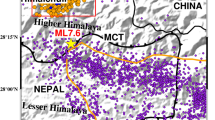Abstract
— The devastating intraplate earthquake of M w 7.7 of 26 January, 2001 took place along the south-dipping reverse fault in the lower crust (∼ 23 km) of Kutch, Gujarat, India, obliterating some 14,000 people. The aftershock activity has ensued for three years. We analyzed 997 aftershocks of M ≥ 3.0 to study the b value and fractal correlation dimensions in time and space. The ‘b’ value is found to be 0.8 ± 0.03 from the Gutenberg-Richter relation and 0.76 ± 0.02 from the maximum-likelihood, suggesting a typical value for the intraplate region. The spatial correlation is 1.71 ± 0.02, indicating that events are approaching a two-dimensional region. Further, the temporal correlation dimension is estimated to be 0.78 ± 0.02, confirming the structure is mono-fractal in time domain. The depth section of b value shows a peak at 15–35 km depth range coinciding with the maximum occurrence of aftershocks (∼ 47%), which is inferred as a fluid-filled highly fractured rock matrix with fractures of high density. It will be important to note that tomographic results also suggest a low Vp, low Vs and a large Poisson’s ratio for the same depth range, further confirming this inference. Additionally, we have studied the variation of D2s and b value with time. During the first two months of aftershock activity the results show a marked negative correlation between spatial correlation dimension D2 (large) and b value (low), indicating the predominance of large events associated with weak clustering. The negative correlation means the stress release along faults of a larger surface area. After two months the fractal dimension (D2s) and b value suggests a positive correlation implying more numerous smaller shocks with stress release along faults of a smaller surface area. This would indicate a reduced probability of large magnitude earthquakes due to fragmentation of the fault zone.
Similar content being viewed by others
Author information
Authors and Affiliations
Corresponding author
Additional information
Acknowledgement. The authors thank Dr. V.P. Dimri, Director, NGRI for his encouragement and kind permission to publish this work. The Department of Science and Technology, New Delhi supported this study.
Rights and permissions
About this article
Cite this article
Mandal, P., Rastogi, B. Self-organized Fractal Seismicity and b Value of Aftershocks of the 2001 Bhuj Earthquake in Kutch (India). Pure appl. geophys. 162, 53–72 (2005). https://doi.org/10.1007/s00024-004-2579-1
Received:
Accepted:
Issue Date:
DOI: https://doi.org/10.1007/s00024-004-2579-1




